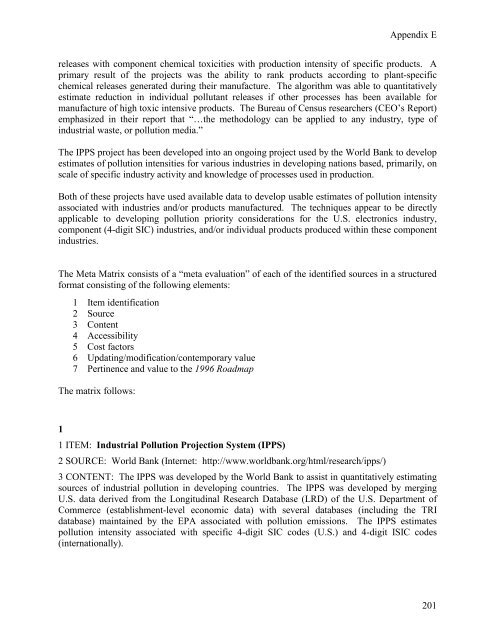1996 Electronics Industry Environmental Roadmap - Civil and ...
1996 Electronics Industry Environmental Roadmap - Civil and ...
1996 Electronics Industry Environmental Roadmap - Civil and ...
You also want an ePaper? Increase the reach of your titles
YUMPU automatically turns print PDFs into web optimized ePapers that Google loves.
Appendix E<br />
releases with component chemical toxicities with production intensity of specific products. A<br />
primary result of the projects was the ability to rank products according to plant-specific<br />
chemical releases generated during their manufacture. The algorithm was able to quantitatively<br />
estimate reduction in individual pollutant releases if other processes has been available for<br />
manufacture of high toxic intensive products. The Bureau of Census researchers (CEO’s Report)<br />
emphasized in their report that “…the methodology can be applied to any industry, type of<br />
industrial waste, or pollution media.”<br />
The IPPS project has been developed into an ongoing project used by the World Bank to develop<br />
estimates of pollution intensities for various industries in developing nations based, primarily, on<br />
scale of specific industry activity <strong>and</strong> knowledge of processes used in production.<br />
Both of these projects have used available data to develop usable estimates of pollution intensity<br />
associated with industries <strong>and</strong>/or products manufactured. The techniques appear to be directly<br />
applicable to developing pollution priority considerations for the U.S. electronics industry,<br />
component (4-digit SIC) industries, <strong>and</strong>/or individual products produced within these component<br />
industries.<br />
The Meta Matrix consists of a “meta evaluation” of each of the identified sources in a structured<br />
format consisting of the following elements:<br />
1 Item identification<br />
2 Source<br />
3 Content<br />
4 Accessibility<br />
5 Cost factors<br />
6 Updating/modification/contemporary value<br />
7 Pertinence <strong>and</strong> value to the <strong>1996</strong> <strong>Roadmap</strong><br />
The matrix follows:<br />
1<br />
1 ITEM: Industrial Pollution Projection System (IPPS)<br />
2 SOURCE: World Bank (Internet: http://www.worldbank.org/html/research/ipps/)<br />
3 CONTENT: The IPPS was developed by the World Bank to assist in quantitatively estimating<br />
sources of industrial pollution in developing countries. The IPPS was developed by merging<br />
U.S. data derived from the Longitudinal Research Database (LRD) of the U.S. Department of<br />
Commerce (establishment-level economic data) with several databases (including the TRI<br />
database) maintained by the EPA associated with pollution emissions. The IPPS estimates<br />
pollution intensity associated with specific 4-digit SIC codes (U.S.) <strong>and</strong> 4-digit ISIC codes<br />
(internationally).<br />
201






